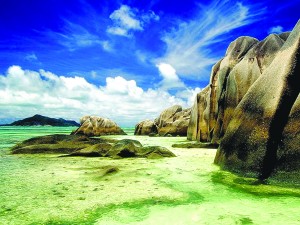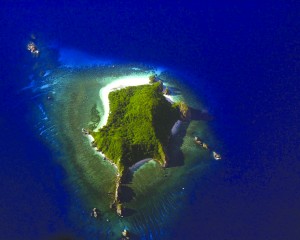Photo: The gorgeous Presidential Suite at the Hilton Bora Bora Nui Resort & Spa is basically an island unto itself stretching out into the crystal clear waters of Bora Bora.
With the recent gay marriage victory in New York, there’s no shortage of far and away locales to celebrate our new rights as first-class citizens. Below are a few of my top choices for an exotic, first-class honeymoon.
The Salient Seychelles

Sandwiched between East Africa and the Maldives, the 115 islands that form Africa’s smallest nation, the Seychelles, are a contrasting mix of low-lying coralline islets and the world’s only high-rising mid-oceanic granite islands. Separated from the former supercont inent of Gondwana over 75 million years ago, the granitic Seychelles is a Darw
in dreamland, blessed with fascinating, endemic flora and fauna that have evolved in isolation across the lush archipelago.
Dotting the emerald coastlines of Mahé island, a handful of luxurious resorts perfectly capture the country’s quintessential juxtaposition of mountainous backdrops, mind-boggling boulders and crystalline waters. Chic amenities undoubtedly enhance the inspirational panoramas, like the private infinity pool behind each tree house villa at the Four Seasons Resort Seychelles (www.fourseasons.com/seychelles, +248 393 000) or the hillside Spa pavilions at the Banyan Tree Seychelles (www.banyantree.com/en/seychelles, +248 383 500).
Travelers who have experienced “The Baths” of Virgin Gorda and found themselves enchanted by the petite cavernous overlay of smooth rock, palm trees and white sands will achieve nirvana in the Seychelles’ ubiquitous equivalent. The natural mazes often lead to deserted banks of turquoise brilliance, sinfully romantic and splendidly private. Complemented by sensational marine life and eclectic cuisine, Africa’s oceanic tropical utopia lives up to its legendary reputation.
Bountiful Beauty in Bora Bora

Since the dawn of the 19th century, Tahiti’s magnetism has been the subject of nearly 15,000 books and articles. While the timeless rapture of its verdant panoramas remains, Tahiti has fallen victim to destructive, anthropogenic realities, forcing travelers to venture deeper into the Society Islands to discover the South Seas’ renowned magic.
Following the gospel of Pulitzer Prize winner James Michener, opulence arrived in nearby Bora Bora by the 1970s, endowing the idyllic island with five star resorts that matched the astounding beauty of Michener’s words. Bora Bora was the birthplace of the overwater bungalow, later popularized in Tahiti and perfected in the Maldives. This concept of luxurious accommodation straddling the ocean floor, immersed in natural azure and emerald hues, in the shadow of jagged mountains, revolutionized the travel market and fostered a paradigm where the formerly unknown Polynesian gem became synonymous with ambiguous terms like “paradise” and “heaven.”
Forty years later, Bora Bora is still a bastion of exclusive and definitive romance with more options than ever for indulging in French Polynesia’s bountiful endowments. Perennial favorites like the Hilton Bora Bora Nui Resort and Spa (www.Hilton.com/Bora-Bora-Nui, +689-60-3300) and welcome newcomers like the St. Regis Resort Bora Bora (www.stregisborabora.com, +689-60-7888) dutifully triumph our expectations of “paradise”.
Turtle Island
In the north westernmost reaches of the Fijian archipelago, the remote Yasawa Islands exemplify the effortless magnificence of the South Pacific, bejeweled with Mother Nature’s finest Harry Winstons. None more so than Nanuya Levu, better known as Turtle Island (www.turtlefiji.com) – a 500-acre landmass, candy-coated with palm trees and turquoise inlets, immortalized in the 1980 version of the classic film, The Blue Lagoon.
Though Hollywood hoopla catalyzed a mass exodus to the South Pacific in search of the movie’s captivating milieu, Turtle Island itself remained a selective retreat, exclusive to the few couples patronizing the “bures” (cottages) on this island oasis. Staying true to sustainability commitments and judicious romanticism, Turtle Island never became a commercialized enterprise. In fact, to this today a maximum of 14 couples roam the island at any given time. This translates to long hours exploring the island’s perimeter and interiors in romantic solitude by foot, by horseback, or by bike; or basking in the tranquility of the holy waters by kayak or sailboat, creating the private moments you will mentally reference throughout your lifetime.
]]>FORT LAUDERDALE, FL – Outpacing the rest of Florida, Greater Fort Lauderdale recorded a 2.6 percent increase in total visitors in 2010, according to year-end estimates. Spending in the local economy by the 10.84 million visitors also rose from $8.47 billion to $8.69 billion. Of those numbers, the LGBT visitors rose to nearly 1 million, They’re spending accounted for $1.1 billion in revenue for the area.
Traffic at Fort Lauderdale/Hollywood Inter-national Airport jumped 6.4 percent. Statewide, Florida saw a 2.1 percent increase in visitors.
“Given the realities of the economy over the past year, these are very impressive figures, clearly demonstrating that Greater Fort Lauderdale’s tourism industry is reaping the rewards of hard work and creative marketing over the past few months. We have every reason to be optimistic about 2011 based on the success of 2010,” said Nicki E. Grossman, president of the Greater Fort Lauderdale Convention & Visitors Bureau.
Greater Fort Lauderdale will show a 2.7 percent increase in domestic visitors in 2010. Canadian visitors increased by 3.6 percent and Latin America by 2.6 percent, including a doubling of arrivals from Brazil, which is now Greater Fort Lauderdale’s second largest foreign market. Growth from Latin America was aided by increased air service from the region by Spirit Airlines and other carriers. Arrivals from Scandinavia, Europe, and the UK also showed modest gains, a reflection of the continued strengthening of the long-haul inbound vacation market.
Fort Lauderdale/Hollywood Inter-national Airport’s year-end figures showed 22,412,627 arriving and departing passengers in 2010, including 18,965,234 domestic travelers, a 5.2 percent gain over a year ago.
Based on 2010 results and a slowly strengthening global economy, Greater Fort Lauderdale officials are forecasting 11 million visitors in 2011.
]]>